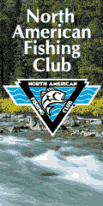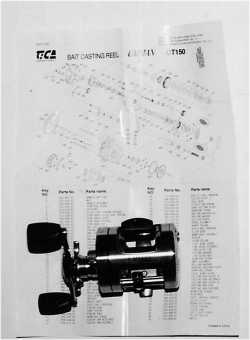
|
|||
|
Promotional Team Favorites Lodging food and more 
Free 90 day Risk free trial offer click here 
|
By JOHN KOLINSKI
Editor's note: John Kolinski is an eight-time championship qualifier during his seven years of professional fishing on the Professional Walleye Trail and Masters Walleye Circuit. His articles can be read in a number of publications and at top walleye-fishing sites on-line. There comes a time every year when the snow is swirling outdoors, the fireplace is crackling indoors, and the open-water fishing gear sits forgotten in the garage or basement. Don't just leave it there while you watch fishing programs on television or dream about your next ice-fishing adventure. All that tackle that serves us so well the rest of the year needs a little attention and care if we expect the same results when the ice melts away in a few months.
It takes just a few minutes to go over all the guides on all your rods. Take a cotton swab and wipe it around the inside of the rod's eyes. If the swab sticks anywhere, the guide needs to be replaced. Rod tips are subject to the most damage risk. Fortunately, they're also the easiest to replace, and tip repair kits can be purchased at most sporting goods outlet stores. Apply heat with a match or a lighter to the shaft of the tip where it slips over the rod blank. In a few seconds, the glue will soften and you can slip the tip off using a pliers or a piece of cloth to protect your fingers from the hot metal. Clean off any remaining glue from the blank, apply a new coat of adhesive, heat it up until it reaches a soft gel state, spread it evenly around the blank with a toothpick or a wooden match, and slip the new tip into place while aligning it with the other guides. Replacing guides farther down the rod blank is a little more involved, but still easy enough to repair. These guides are generally seated with adhesive and wrapped firmly with thread to secure them in place. The thread is then coated with lacquer or a similar substance to protect it from wear and abuse. If you're not comfortable replacing these eyelets, take the rod to a professional. It should be an inexpensive repair. Cork rod handles tend to show some wear and tear, too, and can become slippery as dirt and grime clogs the cork's pores. I bring these back to life by running fine sandpaper or emery cloth over the handle, then wiping it down with a solvent or cleaner. Wipe the rod down, too, to remove any scales, slime, dirt and other grunge that builds up over the course of a season. My next task is cleaning and inspecting my reels. I start with the line, peeling off and discarding 30 feet or so. If the reel is loaded with monofilament and it appears "chalky" looking or has a powery residue, it's time to remove it. If it's Fireline and it's frayed in any way, off it comes. If there's plenty of line on the spool and it's in good shape, just spray it with a light coat of Blakemore's Reel Magic or a similar odorless lubricant, and it's good to go. I don't like to put new line on a reel in the middle of winter. Those that I strip down will remain that way until the open-water season gets much closer. From there, spray a little cleaner on the outside of the reels and wipe them down. Then check to make sure they are working smoothly and properly. If the spool sticks or grinds at all when you turn the reel handle, take the reel apart, clean the inside of the housing, rinse them out with hot water, dry them as thoroughly as possible, apply a light coat of oil to the moving parts and put new grease on the worn gear. When you're checking out spinning reels, make sure the bail is functioning properly, too. If it hangs up at all, it's time to replace the bail spring. I usually give my landing net a good look before I put it away for the winter, too. Check the screws on the handle to make sure they're tight. If it's a telescoping handle, extend it out, clean the shaft and coat it lightly with lubricant. Then take a look at the netting itself. If there are any holes, they need to be repaired or the netting replaced. If you decide it's time for new netting, consider going to a rubber-coated basket that makes it much, much easier to remove fish and hooks. Finally, it's time to go through those tackle boxes, and I've got a lot of them. One thing that helps me organize a vast assortment of crankbaits, jigs and terminal tackle is Flambeau's 5004 soft-sided storage system. I've got dozens of individual boxes of crankbaits sorted usually by brand and size, but in some cases by action and the bait's range of depth. That way, when I'm trolling for deep-water walleyes, I can load all the deep-running baits in the soft-sider. If I'm onto a shallow-water bite, I can replace them with shallow-running cranks. As I work my way through the crankbait boxes, I look for things like bent hooks, rusty hooks, and cracked bodies. When I get to terminal tackle, I make a list of items I need to restock, such as crankbait snaps, spinner clevises or even split-shot. I've got just about as many jigs as crankbaits, and I sort them by style, color and size. Again, the Flambeau soft-sided system is a valuable tool that allows me to keep my Lindy Fuzzy Grubs in one box, my brush jigs in another and my heavier Jumbo Jigs in yet another. Any bucktail, hair jigs or Fuzzy Grubs should be individual packaged to keep them from tangling and to keep them dry. I make sure I've got a good supply of stinger hooks, too, and tie up a few dozen if the supply is short. It's also a good time to make sure there is no paint in the eyes of your jigs. Many come from the store with the eyes painted over, and it's a hassle to clean them out in the boat when your hands are cold. Plastic tails don't always get treated well during the season, either. Now's the time to go through those, and discard the old, faded or well-used ones. With all the sports shows coming up, there will be plenty of opportunities to restock in the next few weeks. Organizing plastics is important, too. Store different colors together and they'll often bleed into one another. Soft plastic pouches on a ring binder are a great way to separate and store plastics. Once I've finished those tasks, I idle away a few more hours tying up spinner rigs. I like to have at least a dozen or so of my favorite combinations ready to go. I'll snell the hooks on another couple dozen blanks so all I have to do is finish them when I need them. Usually, by the time I've made it through all my tackle and gear, spring isn't far off. I'll be ready to go. Will you? E-mail John Kolinski Fish Clix Banner Exchange Please visit these site sponsors |
||
|---|---|---|---|
